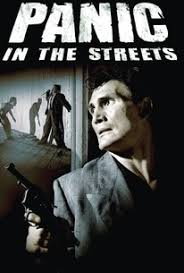
Kochak (Lewis Charles) isn’t feeling well. He decides to cash out early from his poker game and call it a night. Blackie (Jack Palance) is not happy with Kochak cutting out so early and taking his money so he and a couple of his goons Poldi (Guy Thomajan) and Fitch (Zero Mostel) let Kochak know how he feels.
When the dead body of Kochak is fished out of the ocean near the docks it is sent to the morgue. Cause of death is gunshot wound. Kleber (George Ehmig), the medical examiner, notices something unusual with the victim’s blood cells. He contacts Lieutenant Commander Clinton Reed (Richard Widmark) from the US Public Health Service. Reed examines the body and finds the seaman had pneumonic plague.
Pneumonic plague spreads from person to person through the air. When the plague victim breathes, aerosolized bacteria from the infected person can land on another person. The bacteria from the carrier would then infect the person being breathed on. Reed orders anyone who came in contact with Kochak be inoculated.
When the body came into the morgue there was no identification on him. Reed needs to find out who he is and where he came from. Anyone that Kochak had been in contact with during the incubation period of the disease also needs to be inoculated. The mayor and city officials are a little skeptical of Reed’s diagnosis and of his wild claims of urgency. Eventually he convinces them that what they are dealing with is a dire situation and time is of the essence. Reed assures the authorities that they have forty-eight hours to stop the spread of a plague that could affect the entire city of New Orleans. He also needs to keep the press from finding out so as not to panic the city.
“Panic in the Streets” was released in 1950 and was directed by Elia Kazan. It is a melodrama and a film noir. The movie won an Academy Award for Best Writing. There are a lot of good things about this movie. Besides the writing, the acting is great. Especially Jack Palance. This was his first feature-film and he shines. It is a great film and one of Elia Kazan’s lesser known gems.
The action is more intense than you would think. According to Richard Widmark, after two stuntmen failed to be able to do it, Palance did his own stunt where he climbs the ropes of a ship. Widmark said that Palance was the toughest guy he ever met and the only actor that he had ever been physically afraid of. In a scene where Palance knocks Widmark unconscious with a gun the two actors rehearsed the scene with a rubber gun. When the scene was actually being shot Palance substituted a real gun, not telling Widmark. He was out for twenty minutes. In a later interview Widmark also recalled how Palance got into the mood of his character by beating on Zero Mostel off-screen. According to Widmark, a black and blue Mostel had to go to the hospital after his first week on the movie. "They had to soak him in Epsom pads."
The ship that Palance’s character Blackie tries to board at the end of the film is the S.S. Quiriqua. The ship was owned by the United Fruit Co., which is now called Chiquita Brands International. She was built in 1932 to transport fruit, passengers and mail between the U.S. and Central and South America. During WWII she was requisitioned for use in the Pacific and was called the U.S.S. Mizar (AF-12) during her service. She earned four battle stars. After the war she returned to civilian service with United Fruit in 1946 and was scrapped in 1964.
Elia Kazan has a cameo as the mortuary assistant Cleaver.

